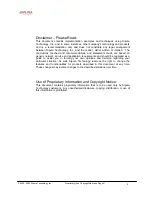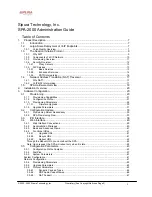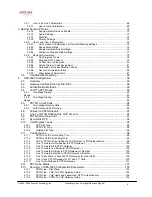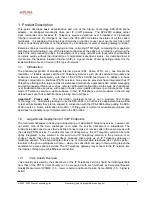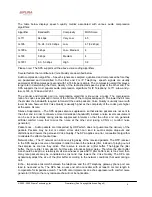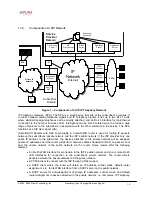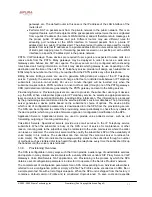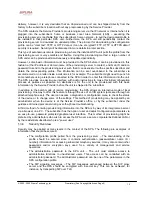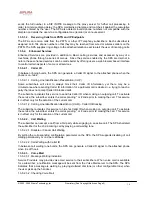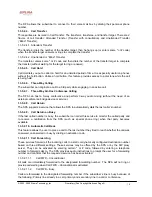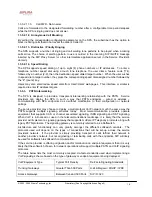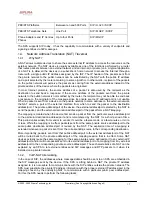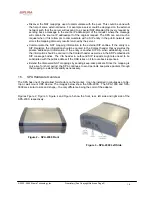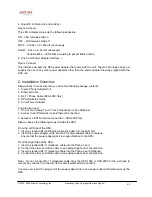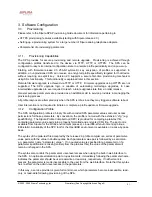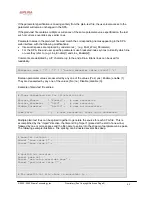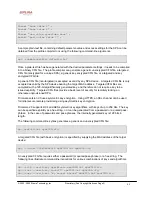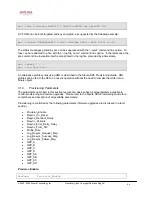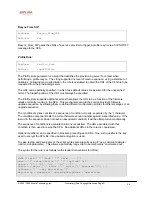
© 2003 - 2005 Sipura Technology, Inc
Proprietary (See Copyright Notice on Page 2)
11
gateways, etc. The default router in this case is the IP address of the LAN interface of the
router itself.
•
Performs NAT on packets sent from the private network to the public network. This is an
important feature such that recipients of the private packets will perceive them as originated
from a public IP address (the router’s WAN interface) and will therefore return messages to
the proper public IP address and port. Different routers may use different rules for
allocating port numbers at the WAN interface to forward packets from a private IP
address/port to a public IP address/port. The allocated port number is also used for routing
packets from external IP addresses to a private address. Most routers will accept a number
of static port mapping rules for forwarding packets received on a specific port at the WAN
interface to a specific IP address/port in the private network.
PSTN - VoIP Gateways: These devices are required if user agents are expected to make calls to or
receive calls from the PSTN. Many gateways may be deployed in order to service a wide area.
Gateways also behave like SIP user agents. The proxy server can be configured with cost-saving
rules based call routing information so that it may decide which gateway to use depending on the
destination and the time of the call. The IP Telephony service provider will assign each subscriber an
E164 telephone number so that it may be reached from the PSTN just like any other telephone.
Billing Servers: Billing servers are used to generate billing data per usage of the IP Telephony
service. Typically, the service provider will charge a flat fee for unlimited calls between IP Telephony
subscribers (on-net-to-on-net calls). Per use or minute chargers will be incurred only when the
subscriber makes calls to PSTN numbers (on-net-to-off-net calls) through one of the PSTN gateways.
CDR (call detail record) data are generated by the PSTN gateway and sent to the billing servers.
Provisioning Servers: Provisioning servers are used to provision the subscriber user agent devices,
e.g. the SPA. When a subscriber signs up for IP Telephony service, he selects an appropriate service
level and enters his personal information including billing information. This information is processed
by the provisioning server and stored into the service provider’s customer database. The provisioning
server generates a device profile based on the subscriber’s choice of options. The device profile,
which is list of configuration parameters, is downloaded into the SPA from the provisioning server.
The SPA can be configured to contact the provisioning server periodically to check for any update of
the device profile, which may include a firmware upgrade or configuration modification to the SPA.
Application Servers: Application servers are used to provide value added services, such as call
forwarding, outgoing or incoming call blocking
Voice Mail Servers: Specialized servers provide voice mail services to the IP Telephony service
subscribers. When the subscriber is busy or the SPA is out of service for maintenance or other
reason, incoming calls to the subscriber may be redirected to the voice mail servers where the caller
can leave a voice mail. The voice mail server will then notify the subscriber’s SPA of the availability of
voice mail(s) in his mailbox. The subscriber can then contact the voice mail server to retrieve his
voice mail(s). The SPA can indicate the message-waiting status to the subscriber through a number
of methods such as stuttered dial tone heard through the telephone every time the subscriber lifts up
the handset until the voice mail is retrieved.
1.3.3. Provisioning
Overview
The SPA is configurable in many ways such that it can provide a wide range of customizable services
and operate in many diverse environments with a variety different vendors’ SIP Proxy Servers, VoIP
Gateways, Voice Mail Servers, NAT applications, etc. Provisioning is the process by which the SPA
obtains a set of configuration parameters in order for it to operate in the Service Provider’s network.
The complete set of configuration parameters for an SPA corresponding to an individual subscriber is
referred to as a configuration profile or simply a Profile. The Profile can be encoded as an XML file or
a simple plain text file with a list of tag/value pairs. When the SPA unit is shipped from the factory, it
contains a default common Profile and is considered Unprovisioned. To save costs and expedite


